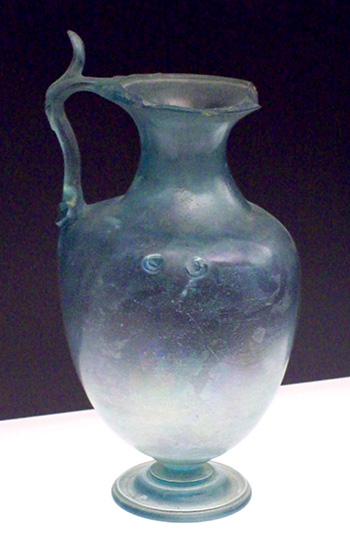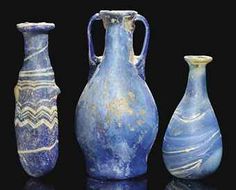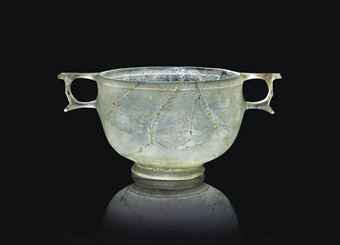 In our two most recent pieces, Black Glass: Before There Was Glassblowing and Coloured Glass: Before The Age of Glass Blowing, we examined the motivations (both practical and cultural) that shaped the genesis of glassmaking. We also explored the ancient trade routes that helped spread glass art around the world, spurring innovations that would ultimately popularise glass. However, no discussion of glassmaking in the Bronze Age would be complete without an investigation into the techniques these early pioneers used to create their works. Only through understanding the difficulties faced by the first glass artists can we truly appreciate the ingenuity of their pieces, and only by comprehending the initial rarity and luxury of glass as a material can we fully appreciate the cultural context that first connected glass to art.
In our two most recent pieces, Black Glass: Before There Was Glassblowing and Coloured Glass: Before The Age of Glass Blowing, we examined the motivations (both practical and cultural) that shaped the genesis of glassmaking. We also explored the ancient trade routes that helped spread glass art around the world, spurring innovations that would ultimately popularise glass. However, no discussion of glassmaking in the Bronze Age would be complete without an investigation into the techniques these early pioneers used to create their works. Only through understanding the difficulties faced by the first glass artists can we truly appreciate the ingenuity of their pieces, and only by comprehending the initial rarity and luxury of glass as a material can we fully appreciate the cultural context that first connected glass to art.
Today, we take the accessibility of manufactured goods largely for granted. In this era of automation and digitization, our wish is the command of machines innumerable, with technology having advanced to a point where we can produce complex items either en masse or as bespoke pieces, printed out within the comfort of our homes. It is therefore difficult for most of us to truly fathom the kind of craftsmanship, creativity, and expertise that went into creating the earliest glass pieces, to put ourselves in the minds of people who—barely removed from the Stone Age—drew up handfuls of sand and ash and began to imagine the possibilities. For all that technology has diversified what it can create, we have all but lost touch with the alchemy of human spirit and raw materials, which was once the mother of all invention.
Bronze Age Glass Art Techniques
During the Bronze Age, manufacturing glass art was a slow, laborious process; not only were furnaces small, but the heat they produced was barely sufficient to melt glass. The blowpipe, the innovation which ultimately allowed glass to become mainstream, would not be experimented with until the first century BCE; until then, the diligent craftsmen of Egypt, Mesopotamia, Greece, and Southern Asia had to manipulate glass via the following methods:
Core Formation
 The earliest glass vessels known to archaeologists, found in the ruins of ancient Mesopotamia, were “core formed”. To create a core-formed vessel, Mesopotamian glassmakers shaped a clay core around a metal rod, baked the core to harden it, and then painstakingly wrapped molten glass around it. Alternately, some artisans would dip the core in the glass.
The earliest glass vessels known to archaeologists, found in the ruins of ancient Mesopotamia, were “core formed”. To create a core-formed vessel, Mesopotamian glassmakers shaped a clay core around a metal rod, baked the core to harden it, and then painstakingly wrapped molten glass around it. Alternately, some artisans would dip the core in the glass.
While the presence of the core ensured that the vessel would have a usable and relatively uniform interior, separating the core from the glass object was no easy task; once the glass had cooled completely, the glassmaker would have to remove the metal rod and then slowly pick out the clay core with a sharp object. Nevertheless, many of these early glass artists chose to take the time to decorate their work; Mesopotamian vessels were often wrapped with threads of coloured glass to create aesthetically pleasing designs.
Fusing and Slumping
 In order to create more complex pieces, glassworkers in ancient Mesopotamia took to using a technique known as “fusing and slumping”. Fusing saw several different pieces of glass being assembled together before the seams were joined using heat, whereas slumping involved taking a piece of glass (sometimes shaped beforehand via fusing) and placing it into a mould, where it could be heated until it “slumped” and conformed to the shape of the mould.
In order to create more complex pieces, glassworkers in ancient Mesopotamia took to using a technique known as “fusing and slumping”. Fusing saw several different pieces of glass being assembled together before the seams were joined using heat, whereas slumping involved taking a piece of glass (sometimes shaped beforehand via fusing) and placing it into a mould, where it could be heated until it “slumped” and conformed to the shape of the mould.
The Hellenistic Greeks used fusing and slumping to great effect, mastering the creation of large pieces like vases, jugs, and various tablewares. They also experimented with the earliest-known rendition of the “millefiori” technique—a method that is still used to create glass art today. (To create their millefiori works, the Greeks placed canes of sliced multi-coloured glass into a mould, then fused them with heat, creating a mosaic effect.)
Chunk Casting
 Chunk casting was popular in the ancient world because, as mentioned in Coloured Glass: Before The Age of Glass Blowing, the recipes needed to create glass from raw materials were so closely guarded during the Bronze Age that they were akin to state secrets. Chunk casting, as the name suggests, utilised premade chunks of unshaped glass (referred to as “ingots”); artisans placed the ingots into clay moulds and then heated them until they took on the mould’s shape. While this method was far from perfect—it produced gases which created swirls and bubbles along the walls of core-formed vessels—these blemishes were, to Bronze Age people still freshly enamoured with this mesmerising new material, a decorative feature.
Chunk casting was popular in the ancient world because, as mentioned in Coloured Glass: Before The Age of Glass Blowing, the recipes needed to create glass from raw materials were so closely guarded during the Bronze Age that they were akin to state secrets. Chunk casting, as the name suggests, utilised premade chunks of unshaped glass (referred to as “ingots”); artisans placed the ingots into clay moulds and then heated them until they took on the mould’s shape. While this method was far from perfect—it produced gases which created swirls and bubbles along the walls of core-formed vessels—these blemishes were, to Bronze Age people still freshly enamoured with this mesmerising new material, a decorative feature.
Glass Grinding
The unsophisticated methods of glass production outlined above seldom ever produced pieces that could be pulled from their moulds and declared complete; these early techniques often left visible excess material along seam lines, among other issues. As such, Bronze Age glass artists would wait for their wares to cool completely, then reach for a specialised grinding stone; with this, they would slowly and carefully grind away excess glass, refine decorations, and eventually produce pieces fit for the Emperors, Kings, and nobles that formed their clientele.
As is so often the case when love is poured into an object wrought by patient hands, there is something enduring, timeless, and moving about many of these very early glass pieces; imperfect though they may be, their appeal as glass art has not waned despite the passing of several thousand years.
